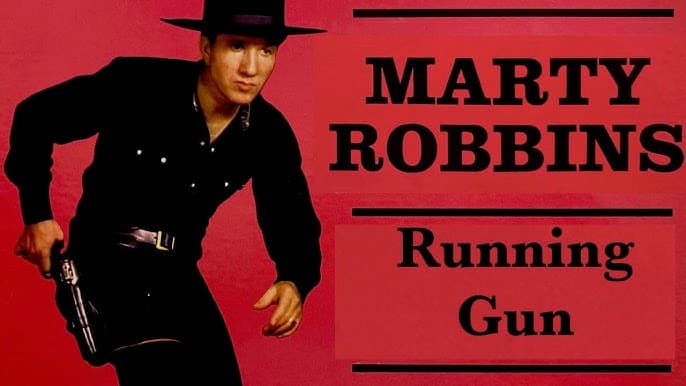
Marty Robbins and the Tragic Ballad of a Wounded Soul
A haunted escape, a fatal reckoning, and the futility of running from the past.
Step back in time, dear friends, to the dusty, sun-baked landscapes of the American West. Not the West of Hollywood grandeur and heroic triumph, but one of moral ambiguity, heavy hearts, and inescapable fate. This is the world that Marty Robbins painted with his musical masterpieces, a world that we, as a generation, knew and felt in our bones. We remember the crackle of the needle on the vinyl, the scent of a summer evening, and the way his voice, a perfect blend of warmth and weary wisdom, could transport us to a world of cowboys and six-shooters. It’s within this tapestry of sound and story that we find “Running Gun,” a song that echoes with the mournful solitude of a man on the run from himself.
This song, from the legendary 1959 album Gunfighter Ballads and Trail Songs, was originally released as the B-side to Marty Robbins’ monumental hit “El Paso.” While “El Paso” captured the world’s imagination and soared to the top of the charts, “Running Gun” played a more subtle, yet equally powerful role. It didn’t have the chart-topping success of its A-side, but its impact, especially on those who truly listened, was profound. It was a somber counterpoint, a moment of quiet reflection after the passionate, sweeping narrative of “El Paso.” It was a glimpse into the darker corners of the gunfighter’s life, a story of regret that resonated deeply.
The story of “Running Gun” is one of a gunslinger for hire who, weary of the violence and burdened by the weight of twenty lives on his soul, decides to abandon his bloody trade. He leaves his past behind, riding for the Mexican border with the hope of a new life and a promise to send for his love. But as the old saying goes, a man can run from the world, but he can’t run from himself. He rides into the town of Amarillo, and before his foot can even touch the ground, a cold voice from the shadows calls his name. It’s a bounty hunter, a manifestation of the past he so desperately tried to outrun. The final confrontation is swift and brutally poetic. The narrator never even clears his holster. His own gun remains in the leather as a testament to his intention to change, but it’s too late. The bounty hunter’s bullet finds its mark, and the running gun falls, his last thought a quiet, heartbreaking warning to his beloved: a woman should never love a running gun.
The genius of this song, written by Tompall Glaser and Jim Glaser, is its raw, unvarnished honesty. It’s not about a glorious showdown; it’s about the futility of escaping one’s destiny. The song’s meaning is a poignant meditation on the consequences of a violent life. It’s a tragic lament, a ballad that reminds us that the choices we make, particularly those that cause pain to others, have a way of catching up with us. The very title, “Running Gun,” is a powerful metaphor for a life perpetually in motion, a soul without a home, haunted by its own history.
For those of us who grew up listening to these songs, they weren’t just entertainment; they were morality plays. They taught us about honor, loss, and the heavy price of a way of life that, while romanticized on the silver screen, was often defined by heartbreak and loneliness. “Running Gun” is a perfect example of this. It’s a reminder of a bygone era, of storytelling that didn’t shy away from the tragic and the profound. It’s a song that, much like an old, faded photograph, still has the power to stir something deep within us, a bittersweet nostalgia for a time when a simple three-minute song could tell a story that would last a lifetime.